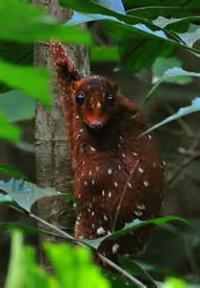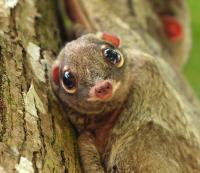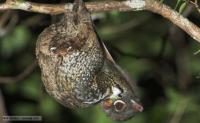Results: Malayan Colugos
Published on 07/15/2015
QUESTIONS
GO to COMMENTS
Comments
1.
1.
Malayan Colugos are little-known, forest-dwelling animals that have huge gliding membranes that enable them to make spectacular leaps from tree to tree in the Asian rainforests. The Sunda Flying Lemur is strictly arboreal and nocturnal. Also known as the Malayan Flying Lemur, is a species of colugo, not a lemur. It is comparable to a medium-sized possum or a very large squirrel. Body length: 34 to 38 cm. Tail length: 24 to 25 cm. Weight: 0.9 to 1.3 kg. Although they are mammals, colugos are marsupial-like in their breeding habits. The young are born after 60 days of pregnancy in a tiny and undeveloped form. Babies spend their first six months or so clinging to the mother's belly. To protect them and transport them she curls her tail up to fold the gliding membrane into a warm, secure quasi-pouch. The young colugos do not reach full size until they are two or three years old. Did you hear about colugos before this survey?
Yes
8%
131 votes
No
92%
1609 votes
2.
2.
They live in lowland tropical rain forests in Brunei Darussalam, Cambodia, Indonesia, Lao People's Democratic Republic, Malaysia, Myanmar, Singapore, Thailand and Vietnam. Did you visit any of these places?

Yes
6%
113 votes
No
94%
1627 votes
3.
3.
Their diet is based on leaves, shoots, flowers and fruit. Their habitat has been dramatically reduced in the last few years. As a result, their population has been reduced in the same proportion. Considering Malaysia has so many rare species, do you think they should work harder to protect endangered species?

Yes
70%
1222 votes
No
30%
518 votes
4.
4.
Lim and Ng (2010) estimated the population density of Sunda Colugos in the protected forests of Singapore at around one animal per two hectares, yielding an estimate of roughly 1000 individuals across Singapore's 2000 hectares of protected forest. The predators threatening them are the Philippine monkey-eating eagle and humans. If you visit the countries mentioned in question 2, would you try to see these animals in their natural habitat?

Yes
50%
874 votes
No
50%
866 votes
COMMENTS


